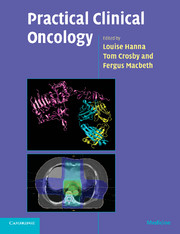Book contents
- Frontmatter
- Contents
- List of contributors
- Preface
- Acknowledgements
- Abbreviations
- 1 Practical issues in cytotoxic chemotherapy usage
- 2 Biological treatments in cancer
- 3 Hormones in cancer
- 4 Radiotherapy planning
- 5 Research in cancer
- 6 Oncological emergencies
- 7 Palliative care
- 8 Head and neck
- 9 Oesophagus
- 10 Stomach
- 11 Liver, gallbladder and biliary tract
- 12 Exocrine pancreas
- 13 Colon and rectum
- 14 Anus
- 15 Gastrointestinal stromal tumours
- 16 Breast
- 17 Kidney
- 18 Bladder
- 19 Prostate
- 20 Testis
- 21 Penis
- 22 Ovary
- 23 Body of the uterus
- 24 Cervix
- 25 Vagina
- 26 Vulva
- 27 Gestational trophoblast tumours
- 28 Lung
- 29 Mesothelioma
- 30 Soft tissue and bone tumours in adults
- 31 The lymphomas and myeloma
- 32 Central nervous system
- 33 Skin cancer other than melanoma
- 34 Melanoma
- 35 Thyroid
- 36 Neuroendocrine tumours
- 37 Cancer in children
- 38 Cancer of unknown primary
- 39 The use of radiotherapy in the treatment of benign conditions
- Multiple choice questions
- Multiple choice answers
- Index
- References
24 - Cervix
Published online by Cambridge University Press: 23 December 2009
- Frontmatter
- Contents
- List of contributors
- Preface
- Acknowledgements
- Abbreviations
- 1 Practical issues in cytotoxic chemotherapy usage
- 2 Biological treatments in cancer
- 3 Hormones in cancer
- 4 Radiotherapy planning
- 5 Research in cancer
- 6 Oncological emergencies
- 7 Palliative care
- 8 Head and neck
- 9 Oesophagus
- 10 Stomach
- 11 Liver, gallbladder and biliary tract
- 12 Exocrine pancreas
- 13 Colon and rectum
- 14 Anus
- 15 Gastrointestinal stromal tumours
- 16 Breast
- 17 Kidney
- 18 Bladder
- 19 Prostate
- 20 Testis
- 21 Penis
- 22 Ovary
- 23 Body of the uterus
- 24 Cervix
- 25 Vagina
- 26 Vulva
- 27 Gestational trophoblast tumours
- 28 Lung
- 29 Mesothelioma
- 30 Soft tissue and bone tumours in adults
- 31 The lymphomas and myeloma
- 32 Central nervous system
- 33 Skin cancer other than melanoma
- 34 Melanoma
- 35 Thyroid
- 36 Neuroendocrine tumours
- 37 Cancer in children
- 38 Cancer of unknown primary
- 39 The use of radiotherapy in the treatment of benign conditions
- Multiple choice questions
- Multiple choice answers
- Index
- References
Summary
Introduction
Cervical cancer is the most common cause of death from female malignancy worldwide. Overall it causes more than 273,000 deaths per year, accounting for 9% of all female cancer deaths. The incidence is highest in developing countries (Ferlay et al., 2004). The major risk factor is persistent human papilloma virus (HPV) infection, particularly types 16 and 18. In the UK the incidence of invasive disease has fallen as a result of cervical screening, and the mortality rates are 60% lower than they were 30 years ago.
For patients presenting with very early stage cancers (stages IA1 to IB1), surgery is the mainstay of treatment. For patients presenting with later-stage disease (IB2 to IVA), the recent standard treatment has become concurrent radiotherapy with cisplatin-based chemotherapy. The prognosis is strongly related to the stage of disease at presentation.
There is major interest in the prospect of cervical cancer prevention via the development of vaccines against HPV infection.
Types of cervical tumour
Cervical tumours can be benign, malignant primary or malignant secondary. The range of tumours is shown in Table 24.1.
Anatomy
The cervix is approximately 2.5 cm long and it is situated in the pelvis at the lower end of the uterus. The lower part of the cervix projects into the vagina. The bladder lies anteriorly, and the pouch of Douglas (which may contain small bowel) and the rectum, posteriorly.
- Type
- Chapter
- Information
- Practical Clinical Oncology , pp. 278 - 289Publisher: Cambridge University PressPrint publication year: 2008

